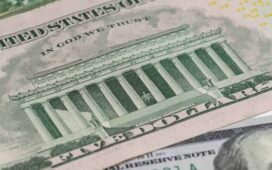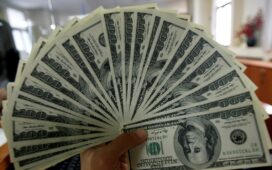(Adds comment in paragraphs 7-8, 17, updates prices at 3 p.m.
ET (2000 GMT)
* Unexpected strong U.S. jobs data sinks rate cut hopes
* Amazon, Meta keep equity market sentiment buoyant
* Shanghai Composite logs worst week in 5 years
* Crude prices post weekly losses of 7%
NEW YORK/LONDON Feb 2 (Reuters) – Treasury yields
jumped, the dollar surged and world equities rallied on Friday
after a blowout U.S. jobs report scuttled any lingering
expectations of a near-term cut in interest rates and
highlighted a strong economy.
Nonfarm payrolls increased by 353,000 jobs in January, the
Labor Department’s Bureau of Labor Statistics said, almost
double the 180,000 forecast by economists polled by Reuters.
The benchmark 10-year Treasury note yield shot
above 4% and the dollar gained against all major currencies as
employers added far more jobs than expected and average hourly
earnings increased 0.6% after rising 0.4% in December.
The data came after the Federal Reserve on Wednesday pushed
back against market expectations for an imminent rate cut, with
Chair Jerome Powell warning inflation was “still too high.”
“The market has been horribly wrong about the near-term
trajectory of Fed policy and this is another instance where
that’s the case,” said Kevin Gordon, senior investment
strategist at Charles Schwab in New York.
“The market’s been correct in assessing that the
inflationary backdrop is going to help set the conditions for
the Fed to cut,” he said. “But it’s probably ultimately the
labor market that’s going to push them into cutting and then
will determine the pace and the size of cuts themselves.”
Employment growth had been decelerating, especially into the
fourth quarter of last year, but the jobs report showed job
creation accelerating, said Joseph LaVorgna, chief U.S.
economist at SMBC Nikko Securities America.
“When you go through all the specific details, there were
really very few if any pockets of weakness. It was just a very,
very strong report and that by itself would suggest that a
recession certainly isn’t imminent,” he said.
MSCI’s gauge of stocks across the globe
advanced 0.74% while on Wall Street, the tech-laden Nasdaq
and benchmark S&P 500 rose 1.86% and 1.30%
respectively, as investors cheered robust quarterly results from
Meta Platforms and Amazon.com.
Gains by the Dow Industrials were a bit more subdued,
rising 0.61%, but low unemployment and a strong economy suggest
corporate earnings can increase.
Meta surged 20.8% to hit a record high after issuing its
first dividend days ahead of Facebook’s 20th anniversary, along
with a revenue and profit beat on advertising sales in the
holiday shopping period.
U.S. regional bank stocks recovered slightly from a brutal
sell-off sparked by concerns that New York Community Bancorp’s
dismal earnings signaled broader problems for the
sector.
NYCB shares were up 5.0% following a nearly 45% plunge over
the last two sessions after the lender slashed its dividend and
posted a surprise loss on commercial real estate loans.
In Japan, Aozora Bank slumped to a three-year low
after it took a huge loan-loss provision against U.S. office
loans.
After the jobs report, money markets projected the Fed would
lower its target rate, currently in a range of 5.25%-5.5%, by
123.3 basis points by year-end, down from 140.3 bps
just before the data was released.
Futures pared bets for a rate cut in March to 20.5% from
36.5% just before the report, and slashed the likelihood of a 25
or 50 bps cut in May to 61.4% from 91.6%, according to CME
Group’s FedWatch Tool.
“I’ll trade a stronger economy with less rate cuts than a
weaker economy with more rate cuts,” said Keith Lerner, chief
market strategist at Truist Wealth in Atlanta.
The two-year Treasury yield, which reflects
interest rate expectations, surged 17.8 basis points to 4.372%
and the 10-year’s yield rose 17 basis points to
4.033%. The 10-year’s rise was on track to post the biggest
one-day gain since September 2022, and the two-year since May
2023.
RISKS
Investors brushed off a big Chinese market selloff caused by
a lack of hoped-for government stimulus.
The blue-chip CSI300 hit a five-year low, with the
Shanghai Composite 1.5% lower on the day and down 6.2%
for the week, its largest weekly loss since October 2018.
The dollar index, a measure of the U.S. currency
against six others, jumped to a seven-week high as it rose
0.84%, while the euro was down 0.74% to $1.0792. The yen
weakened 1.26% to 148.31 per dollar,
Oil prices dipped about 2% setting up both benchmarks for a
weekly loss given China’s faltering economy and persistent
geopolitical tensions.
Oil prices fell by about 2% after the U.S. jobs data reduced
the odds of imminent rate cuts, which could dampen crude demand
if restrictive monetary policy curbs the economy.
U.S. crude futures settled down $1.54 at $72.28 a
barrel, while Brent fell $1.37 to settle at $77.33. Both
benchmarks posted losses of more than 7% for the week.
Gold prices slipped as the dollar jumped, making bullion
more expensive for overseas buyers, and higher yields reduced
the appeal of non-interest bearing gold.
U.S. gold futures settled 0.8% lower at $2053.70 an
ounce.
(Reporting by Herbert Lash, additional reporting by Chuck
Mikolajczak, Naomi Rovnick, Dhara Ranashinghe and Stella Qiu.
Editing by Andrew Heavens, Kirsten Donovan and Cynthia Osterman)




